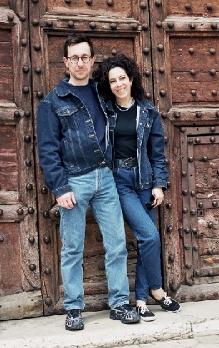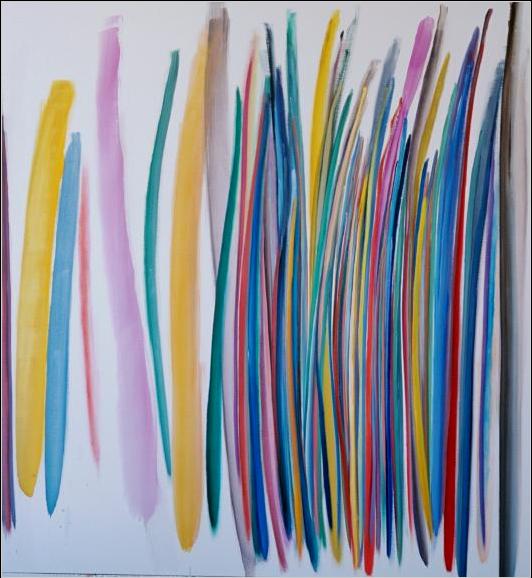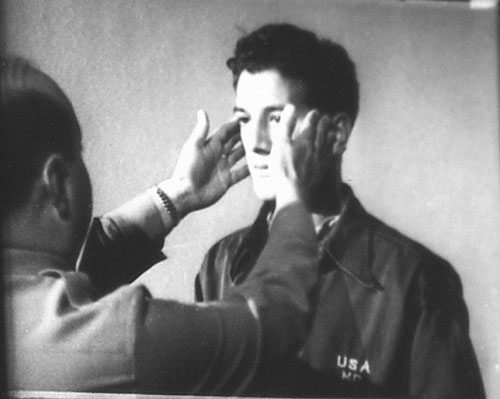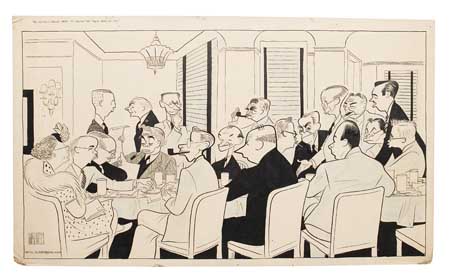• MONDAY, MAY 26 I had a nightmare about The Letter, the first time I’ve ever dreamed about it. In my dream, Paul Moravec and I were about to lead a workshop performance of our opera at a summer festival that took place in a clearing in some unspecified forest. A hundred or so singers and instrumentalists were seated on two sets of bleachers, waiting for us to get started. Then Truman Capote, dressed in a red leisure suit, stood up and addressed the assembled performers. “I’m sorry,” he said, “but I don’t approve of any of this. It simply isn’t true.” He walked out–and the whole cast followed him….
I woke up, looked at the alarm clock, saw that it was five-thirty in the morning, and muttered a four-letter word of the highest possible voltage. I had to be at Adrienne Farb‘s Upper West Side apartment at eight, meaning that there wasn’t much point in trying to go back to sleep. Instead I got out of bed, climbed down from the loft, took a shower, and wrote for an hour and a half.
 Adrienne is an abstract artist whose style has fascinated me ever since I first read about it three years ago. Her work bears a superficial resemblance to the color-field paintings of Morris Louis, especially when seen in reproduction, but it looks completely different in person, crisper and more dynamic, and the more I saw of it, the more interested I became. Last winter I nearly bought one of her works on paper, but I got married instead, which soaked up all my spare change. Then a mutual acquaintance put us in touch via e-mail. It turned out that we were neighbors, so she invited me to visit her studio in the Bronx. Several months went by before we could find a morning when I was in town and we were both free, but we finally pinned down a date, and after coffee and conversation with Adrienne and her very nice husband Clément, we took a bus and a subway up to her studio, where I spent two and a half increasingly excited hours looking at her paintings.
Adrienne is an abstract artist whose style has fascinated me ever since I first read about it three years ago. Her work bears a superficial resemblance to the color-field paintings of Morris Louis, especially when seen in reproduction, but it looks completely different in person, crisper and more dynamic, and the more I saw of it, the more interested I became. Last winter I nearly bought one of her works on paper, but I got married instead, which soaked up all my spare change. Then a mutual acquaintance put us in touch via e-mail. It turned out that we were neighbors, so she invited me to visit her studio in the Bronx. Several months went by before we could find a morning when I was in town and we were both free, but we finally pinned down a date, and after coffee and conversation with Adrienne and her very nice husband Clément, we took a bus and a subway up to her studio, where I spent two and a half increasingly excited hours looking at her paintings.
I liked everything I saw, but this large 2007 canvas, “Fruitti di Bosco, No. 2,” spoke to me most powerfully and immediately:

Afterward I rushed down to Penn Station, stopping at a mailbox along the way to send in my Tony Awards ballot, and headed north to Hartford to rejoin Mrs. T in the woods of Connecticut.
• TUESDAY, MAY 27 Today I wrote a drama column, reread two Parker novels, took a much-needed nap, ate home cooking, and watched an old George Sanders movie.
• WEDNESDAY, MAY 28 Today I wrote a Commentary essay, took a ride with Mrs. T and listened to two episodes of Bob Dylan’s Theme Time Radio Hour on the car radio, reread another Parker novel, took yet another much-needed nap, ate more home cooking, and watched The Asphalt Jungle with Mrs. T, who likes caper movies as much as I do.
 • THURSDAY, MAY 29 Mrs. T and I had John Huston on our minds after watching The Asphalt Jungle, so courtesy of the Documentary Channel, we watched two of his World War II documentaries, The Battle of San Pietro and Let There Be Light, the second of which is unavailable on DVD but can be viewed online by going here. I’d never seen either film, and they both turned out to be as good as their reputations.
• THURSDAY, MAY 29 Mrs. T and I had John Huston on our minds after watching The Asphalt Jungle, so courtesy of the Documentary Channel, we watched two of his World War II documentaries, The Battle of San Pietro and Let There Be Light, the second of which is unavailable on DVD but can be viewed online by going here. I’d never seen either film, and they both turned out to be as good as their reputations.
(Second of three parts)
Archives for June 3, 2008
TT: In a galaxy far, far away
The New York Drama Critics’ Circle, of which I am a member, was founded in 1935. Six years later Al Hirschfeld drew the then-current membership, portraying them in camera at the Algonquin Hotel:

Hirschfeld’s caricature was published in the New York Times in April of 1941. The original, I learned the other day, is being auctioned off later this month by Swann Galleries. I was fascinated to read the names of the members pictured therein: Rosamund Gilder, Joseph Wood Krutch, Richard Watts, Jr., John Mason Brown, Walter Winchell, George Jean Nathan, Sidney Whipple, Brooks Atkinson, Arthur Pollock, Grenville Vernon, Stark Young, Wolcott Gibbs, Burns Mantle, Richard Lockridge, Louis Kronenberger, Kelcey Allen, Oliver Claxton, John Anderson, and John Gassner. In their day, several of these critics wielded considerable power. Two or three of them are still remembered, and one or two others ought to be. The rest, however, are long forgotten–and rightly so.
“Never pay any attention to what critics say,” Jean Sibelius once told a colleague. “Remember, a statue has never been set up in honor of a critic!” While this is not quite true, it is, as they say, close enough for jazz. So I found it oddly touching to see that Hirschfeld, who for much of the twentieth century was one of America’s arbiters of celebrity, had once upon a time taken the trouble to draw nineteen of my erstwhile colleagues. It isn’t a statue, but it’s not bad.
TT: Almanac
“New York, home of the vivisectors of the mind, and of the mentally vivisected still to be reassembled, of those who live intact, habitually wondering about their states of sanity, and home of those whose minds have been dead, bearing the scars of resurrection.”
Muriel Spark, The Hothouse by the East River
